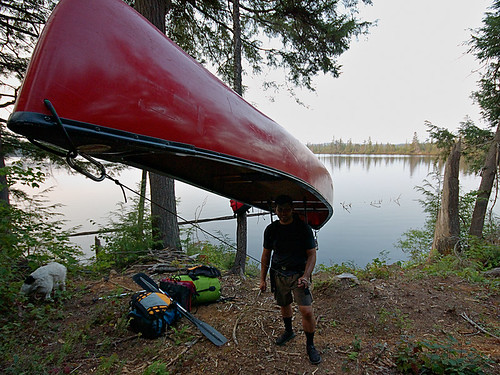 |
| Almost the end of a short day of paddling and a long day of portaging, camp is across the lake! |
...well we'll find out just what the law is and how it pertains to paddlers, thanks to our fearless editor of the Adirondack Explorer.
Phil Brown, editor of the Adirondack Explorer, and a pretty good writer and outdoorsman, doesn't just talk the talk, he walks the walk and paddles the boat. As a result, the Brandreth Park Association (which appears to be a single person or family) and Friends of Thayer Lake have decided to make an example of Phil Brown in order to keep its waters safe from navigation by the rest of the paddling community. Phil, of course needed a lesson, after all, his pen is mightier than the potentially illegal signs and barriers that shoreline owners have erected to illegally prevent navigation.
First, Phil is hardly a criminal. The New York State Department of Environmental Conservation has already informed the above groups that paddlers DO have a right to paddle through the private shoreline in question. All Phil did was exercise his legal rights and remind others about their rights. Secondly, if you've ever read Phil's columns or blog post then you know he doesn't tiptoe around controversial topics. This was clearly no different.
Brown said he paddled through the private land and wrote about it because he believes the public has a right to. “The Lila Traverse is one of the best wilderness canoe routes in the Adirondacks,” he said. “Replacing a long slog on foot with an hour or so of great canoeing only makes it better.” - via Syracuse.com
The issue at hand is centuries old common law which has been upheld in various state courts of law, but the Adirondacks seem to be an exception to this. As a matter of fact, the famous author and paddling advocate, Paul Jamison, remarked how the laws of navigation within the Adirondack Park were strangely different from outside of it. The reason this is odd is that the majority of the land within the Adirondack Park is state forest preserve -Forever Wild- and owned by the people of the state for free use. However, much of that land is in a piecemeal checker board layout that means quite a bit of private land borders state lands. Often and in-holding separates two parcels of state land. This of course causes quite a bit of contention in many cases.
Oddly, in the Adirondacks it is assumed that if a body of water, though accessible and navigable without need to trespass on land, is surrounded by private property, the water is off limits to boaters. However, in the rest of the state people regularly paddle and boat through waters surrounded by private shorelines without incident.
The issue is sticky, but has centuries old legal precedent because: 1) water was/is essential for transportation and commerce; 2) you technically cannot own water or the water bed of navigable water ways, in such cases the state owns the stream bed and it must be left open to public egress. Thus, it's generally accepted that provided you remain below the high water mark of a generally navigable waterway you have the right to travel on that waterway, even if you have to exit your boat due to temporary obstructions, low water levels, or to line your boat downstream or upstream. Keep in mind there are lots of little exceptions that prevent this from being a free for all. As an example, just because I can paddle into an outlet less lake without stepping on land, it doesn't mean I am not trespassing. If the lake is surrounded by private land with no outlet or egress to state land, it's off limits. Likewise, if a body of water isn't considered navigable during median flow, it is off limits. The key thing I'm trying to point out about navigation rights is that they are in fact about navigation and commerce, not the erosion of people's property rights as the Brandeth Park and Thayer Lake groups would have you believe.
This particular issue resonates deeply with me, and is more than just an opportunity to stand on my soapbox. In 2007 my wife and I were one of the first groups to paddle the not yet officially opened Whitney Traverse, which essentially allows you to paddle from Little Tupper to either Lake Lila, the Bog River, or a complete circle from Round Lake. Truthfully, you can essentially go anywhere within hundreds of miles via various options, but those are the basic options that make up the trip. Regardless of how far you travel, you always have to portage over several sections of land when starting from Little Tupper Lake, but one section is clearly avoidable just by looking at the map.
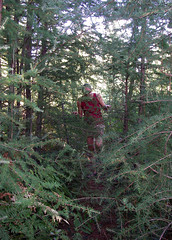 |
| Portage path from Lilypad Pond |
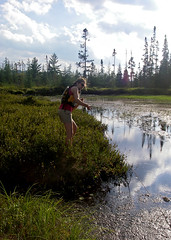 | |
| Pulling 150lbs over low water mud |
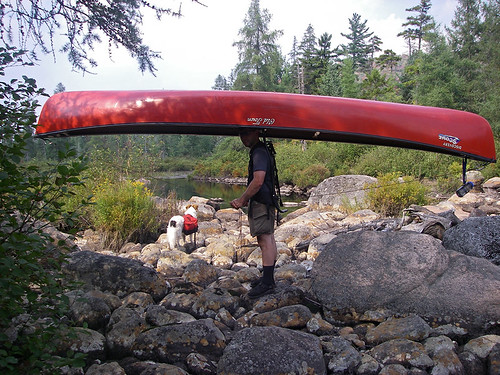 |
| Portage to Harrington Brook |
Often legal action is threatened but never used when the outcome is uncertain, in this case it's clear the plaintiffs could lose. As a matter of fact, it seems unlikely they will win because while they chose Phil Brown, they are really taking on the state of New York and legal precedent. I'm genuinely hoping Brandeth Park Association and Friends of Thayer Lake played their cards poorly in this last ditch effort, and when the gavel drops we have a definitive ruling that upholds the rights of navigation for paddlers and other boaters inside and outside the Blue Line!
Good luck Phil Brown!
 |
| Phil Brown paddling the meandering scenic Shingle Shanty Brook |
For more on this issue:
http://www.syracuse.com/news/index.ssf/2010/11/adirondack_landowners_sue_padd.html








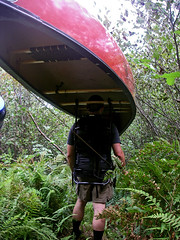



Thank you for the excellent synopsis of this issue.
ReplyDelete